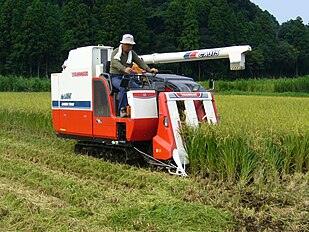Cereal

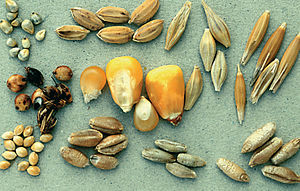
(middle)sorghum,maize,oats
(bottom)millet,wheat,rye,triticale
Acerealis agrasscultivated for its ediblegrain.Cereals are the world's largest crops, and are thereforestaple foods.They includerice,wheat,rye,oats,barley,millet,andmaize.Edible grains from other plant families, such asbuckwheatandquinoa,arepseudocereals.Most cereals areannuals,producing one crop from each planting, though rice is sometimes grown as aperennial.Winter varieties are hardy enough to be planted in the autumn, becoming dormant in the winter, and harvested in spring or early summer; spring varieties are planted in spring and harvested in late summer. The term cereal is derived from the name of theRoman goddessof grain crops and fertility,Ceres.
Cereals weredomesticatedin theNeolithic,some 8,000 years ago.Wheatandbarleywere domesticated in theFertile Crescent;ricewas domesticated in East Asia, andsorghumandmilletwere domesticated in West Africa. In the 20th century, cereal productivity was greatly increased by theGreen Revolution.This increase in production has accompanied agrowing international trade,with some countries producing large portions of the cereal supply for other countries.
Cereals provide food eaten directly aswhole grains,usually cooked, or they are ground toflourand made intobread,porridge,and other products. Cereals have a highstarchcontent, enabling them to be fermented intoalcoholic drinkssuch asbeer.Cereal farming has a substantialenvironmental impact,and is often produced in high-intensitymonocultures.The environmental harms can be mitigated bysustainable practiceswhich reduce the impact on soil and improve biodiversity, such asno-till farmingandintercropping.
History
[edit]Origins
[edit]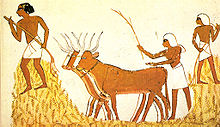
Wheat, barley,rye,andoatswere gathered and eaten in theFertile Crescentduring the earlyNeolithic.Cereal grains 19,000 years old have been found at theOhalo IIsite inIsrael,with charred remnants of wild wheat and barley.[1]
During the same period, farmers inChinabegan tofarm riceand millet, using human-made floods andfiresas part of their cultivation regimen.[2][3]The use ofsoil conditioners,includingmanure,fish,compostandashes,appears to have begun early, and developed independently in areas of the world includingMesopotamia,theNile Valley,and Eastern Asia.[4]
Cereals that becamemodern barley and wheat weredomesticatedsome 8,000 years ago in the Fertile Crescent.[5]Millets and rice were domesticated in East Asia, whilesorghumand other millets were domesticated in sub-Saharan West Africa, primarily as feed for livestock.[6]

In these agricultural regions, religion was often shaped by the divinity associated with the grain and harvests. In the Mesopotamian creation myth, an era of civilization is inaugurated by the grain goddessAshnan.[7]The Roman goddessCerespresided over agriculture, grain crops, fertility, and motherhood;[8]the term cereal is derived from Latincerealis,"of grain", originally meaning "of [the goddess] Ceres".[9]Several gods of antiquity combined agriculture and war: the HittiteSun goddess of Arinna,the CanaaniteLahmuand the RomanJanus.[10]
Complexcivilizationsarose where cereal agriculture created a surplus, allowing for part of the harvest to be appropriated from farmers, allowing power to be concentrated in cities.[11]
Modern
[edit]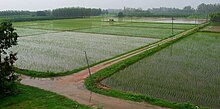
During the second half of the 20th century, there was a significant increase in the production of high-yield cereal crops worldwide, especially wheat and rice, due to theGreen Revolution,a technological change funded by development organizations.[14]The strategies developed by the Green Revolution, including mechanized tilling,monoculture,nitrogen fertilizers, and breading of new strains of seeds. These innovations focused on fending off starvation and increasing yield-per-plant, and were very successful in raising overall yields of cereal grains, but paid less attention to nutritional quality.[15]These modern high-yield cereal crops tend to havelow-quality proteins,withessential amino aciddeficiencies, are high incarbohydrates,and lack balancedessential fatty acids,vitamins,mineralsand other quality factors.[15]So-calledancient grainsandheirloom varietieshave seen an increase in popularity with the"organic" movementsof the early 21st century, but there is a tradeoff in yield-per-plant, putting pressure on resource-poor areas asfood cropsare replaced withcash crops.[16]
Biology
[edit]
Cereals are grasses, in thePoaceaefamily, that produce ediblegrains.A cereal grain is botanically acaryopsis,afruitwhere theseed coatis fused with thepericarp.[17][18]Grasses havestemsthat are hollow except at thenodesand narrow alternate leaves borne in two ranks.[19]The lower part of each leaf encloses the stem, forming a leaf-sheath. The leaf grows from the base of the blade, an adaptation that protects the growing meristem from grazing animals.[19][20]The flowers are usuallyhermaphroditic,with the exception ofmaize,and mainlyanemophilousor wind-pollinated, although insects occasionally play a role.[19][21]
Among the best-known cereals are maize,rice,wheat, barley,sorghum,millet,oat, rye andtriticale.[22]Some other grains are colloquially called cereals, even though they are not grasses; thesepseudocerealsincludebuckwheat,quinoa,andamaranth.[23]
Cultivation
[edit]All cereal crops are cultivated in a similar way. Most areannual,so after sowing they are harvested just once.[24]An exception is rice, which although usually treated as an annual can survive as aperennial,producing aratooncrop.[25]Cereals adapted to atemperate climate,such asbarley,oats,rye,spelt,triticale,andwheat,are called cool-season cereals. Those preferring atropical climate,such asmilletandsorghum,are called warm-season cereals.[24][26][27]Cool-season cereals, especially rye, followed by barley, are hardy; they grow best in fairly cool weather, and stop growing, depending on variety, when the temperature goes above around 30 °C or 85 °F. Warm-season cereals, in contrast, require hot weather and cannot tolerate frost.[24]Cool-season cereals can be grown in highlands in the tropics, where they sometimes deliver several crops in a single year.[24]
Planting
[edit]
In the tropics, warm-season cereals can be grown at any time of the year. In temperate zones, these cereals can only be grown when there is no frost. Most cereals are planted intilled soils,which reduces weeds and breaks up the surface of a field. Most cereals need regular water in the early part of their life cycle. Rice is commonly grown in flooded fields,[28]though some strains are grown on dry land.[29]Other warm climate cereals, such as sorghum, are adapted to arid conditions.[30]
Cool-season cereals are grown mainly in temperate zones. These cereals often have both winter varieties for autumn sowing, winter dormancy, and early summer harvesting, and spring varieties planted in spring and harvested in late summer. Winter varieties have the advantage of using water when it is plentiful, and permitting a second crop after the early harvest. They flower only in spring as they requirevernalization,exposure to cold for a specific period, fixed genetically. Spring crops grow when it is warmer but less rainy, so they may need irrigation.[24]
Growth
[edit]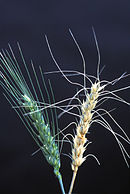
Cereal strains are bred for consistency and resilience to the local environmental conditions. The greatest constraints onyieldareplant diseases,especiallyrusts(mostly thePucciniaspp.) andpowdery mildews.[31]Fusarium head blight, caused byFusarium graminearum,is a significant limitation on a wide variety of cereals.[32]Other pressures includepest insectsand wildlife like rodents and deer.[33][34]In conventional agriculture, some farmers will applyfungicidesor pesticides
Harvesting
[edit]Annual cereals die when they have come to seed, and dry up. Harvesting begins once the plants and seeds are dry enough. Harvesting in mechanized agricultural systems is bycombine harvester,a machine which drives across the field in a single pass in which it cuts the stalks and thenthreshesandwinnowsthe grain.[24][35]In traditional agricultural systems, mostly in theGlobal South,harvesting may be by hand, using tools such asscythesandgrain cradles.[24]Leftover parts of the plant can be allowed to decompose, or collected asstraw;this can be used for animal bedding, mulch, and a growing medium for mushrooms.[36]It is used in crafts such as building withcoborstraw-bale construction.[37]
-
A small-scale ricecombine harvesterin Japan
Preprocessing and storage
[edit]If cereals are not completely dry when harvested, such as when the weather is rainy, the stored grain will be spoilt bymouldfungi such asAspergillusandPenicillium.[24][38]This can be prevented by drying it artificially. It may then be stored in agrain elevatororsilo,to be sold later. Grain stores need to be constructed to protect the grain from damage by pests such as seed-eating birds androdents.[24]
-
Grain elevatorson a farm in Israel
Processing
[edit]
When the cereal is ready to be distributed, it is sold to a manufacturing facility that first removes the outer layers of the grain for subsequentmilling for flouror other processing steps, to produce foods such as flour,oatmeal,orpearl barley.[39]In developing countries, processing may be traditional, in artisanal workshops, as withtortilla productionin Central America.[40]
Most cereals can be processed in a variety of ways.Rice processing,for instance, can create whole-grain or polished rice, or rice flour. Removal of the germ increases the longevity of grain in storage.[41]Some grains can bemalted,a process of activating enzymes in the seed to cause sprouting that turns the complex starches into sugars before drying.[42][43]These sugars can be extracted for industrial uses and further processing, such as for makingindustrial alcohol,[44]beer,[45]whisky,[46]orrice wine,[47]or solddirectly as a sugar.[48]In the 20th century,industrial processesdeveloped around chemically altering the grain, to be used for other processes. In particular,maizecan be altered to produce food additives, such ascorn starch[49]andhigh-fructose corn syrup.[50]
Effects on the environment
[edit]Impacts
[edit]
Cereal production has a substantial impact on the environment.Tillagecan lead tosoil erosionand increased runoff.[51]Irrigation consumes large quantities of water; its extraction from lakes, rivers, oraquifersmay havemultiple environmental effects,such as lowering thewater tableand cause salination of aquifers.[52]Fertilizerproduction contributes toglobal warming,[53]and its use can lead to pollution andeutrophicationof waterways.[54]Arable farming uses large amounts offossil fuel,releasing greenhouse gaseswhich contribute to global warming.[55]Pesticide usage can cause harm to wildlife, such asto bees.[56]
Mitigations
[edit]
Some of the impacts of growing cereals can be mitigated by changing production practices. Tillage can be reduced byno-till farming,such as by direct drilling of cereal seeds, or by developing and plantingperennial cropvarieties so that annual tilling is not required. Rice can be grown as aratooncrop;[25]and other researchers are exploring perennial cool-season cereals, such askernza,being developed in the US.[57]
Fertilizer and pesticide usage may be reduced in somepolycultures,growing several crops in a single field at the same time.[58]Fossil fuel-basednitrogen fertilizerusage can be reduced byintercroppingcereals withlegumeswhichfix nitrogen.[59]Greenhouse gas emissions may be cut further by more efficient irrigation or by water harvesting methods likecontour trenchingthat reduce the need for irrigation, and by breeding new crop varieties.[60]
Uses
[edit]Direct consumption
[edit]Some cereals such as rice require little preparation before human consumption. For example, to make plaincooked rice,rawmilled riceis washed and boiled.[61]Foods such asporridge[62]andmueslimay be made largely of whole cereals, especially oats, whereas commercialbreakfast cerealssuch asgranolamay be highly processed and combined with sugars,oils,and other products.[63]
Flour-based foods
[edit]
Cereals can begroundto make flour.Wheat flouris the main ingredient ofbreadandpasta.[64][65][66]Maize flour has been important inMesoamericasince ancient times, with foods such as Mexicantortillasandtamales.[67]Rye flour is a constituent of bread in central and northern Europe,[68]whilerice flouris common in Asia.[69]
A cereal grain consists of starchyendosperm,germ,andbran.Wholemeal flour contains all of these; white flour is without some or all of the germ or bran.[70][71]
Alcohol
[edit]Because cereals have a high starch content, they are often used to makeindustrial alcohol[44]andalcoholic drinksbyfermentation.For instance,beeris produced bybrewingand fermentingstarch,mainly from cereal grains—most commonlymaltedbarley.[45]Rice winessuch as Japanesesakeare brewed in Asia;[72]a fermented rice and honey wine was made in China some 9,000 years ago.[47]
Animal feed
[edit]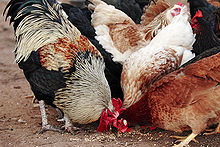
Cereals and their related byproducts such ashayare routinelyfed to farm animals.Common cereals as animal food include maize, barley, wheat, and oats. Moist grains may be treated chemically or made intosilage;mechanically flattened or crimped, and kept in airtight storage until used; or stored dry with a moisture content of less than 14%.[74]Commercially, grains are often combined with other materials and formed into feed pellets.[75]
Nutrition
[edit]Whole-grain and processed
[edit]
Aswhole grains,cereals providecarbohydrates,polyunsaturated fats,protein,vitamins,andminerals.When processed by the removal of the bran and germ, all that remains is the starchy endosperm.[70]In somedeveloping countries,cereals constitute a majority of daily sustenance. Indeveloped countries,cereal consumption is moderate and varied but still substantial, primarily in the form of refined and processed grains.[77]
Amino acid balance
[edit]Some cereals are deficient in the essential amino acidlysine,obliging vegetarian cultures to combine their diet of cereal grains withlegumesto obtain a balanced diet. Many legumes, however, are deficient in the essential amino acidmethionine,which grains contain. Thus,a combinationof legumes with grains forms a well-balanced diet for vegetarians. Such combinations includedal(lentils) with rice bySouth IndiansandBengalis,beanswithmaize tortillas,tofuwith rice, andpeanut butterwith wholegrain wheat bread (as sandwiches) in several other cultures, including the Americas.[78]Forfeeding animals,the amount ofcrude proteinmeasured in grains is expressed as grain crude protein concentration.[79]
Comparison of major cereals
[edit]| Per 45g serving | Barley | Maize | Millet | Oats | Rice | Rye | Sorgh. | Wheat | |
|---|---|---|---|---|---|---|---|---|---|
| Energy | kcal | 159 | 163 | 170 | 175 | 165 | 152 | 148 | 153 |
| Protein | g | 5.6 | 3.6 | 5.0 | 7.6 | 3.4 | 4.6 | 4.8 | 6.1 |
| Lipid | g | 1 | 1.6 | 1.9 | 3.1 | 1.4 | 0.7 | 1.6 | 1.1 |
| Carbohydrate | g | 33 | 35 | 31 | 30 | 31 | 34 | 32 | 32 |
| Fibre | g | 7.8 | 3.3 | 3.8 | 4.8 | 1.6 | 6.8 | 3.0 | 4.8 |
| Calcium | mg | 15 | 3 | 4 | 24 | 4 | 11 | 6 | 15 |
| Iron | mg | 1.6 | 1.5 | 1.3 | 2.1 | 0.6 | 1.2 | 1.5 | 1.6 |
| Magnesium | mg | 60 | 57 | 51 | 80 | 52 | 50 | 74 | 65 |
| Phosphorus | mg | 119 | 108 | 128 | 235 | 140 | 149 | 130 | 229 |
| Potassium | mg | 203 | 129 | 88 | 193 | 112 | 230 | 163 | 194 |
| Sodium | mg | 5 | 16 | 2 | 1 | 2 | 1 | 1 | 1 |
| Zinc | mg | 1.2 | 0.8 | 0.8 | 1.8 | 1.0 | 1.2 | 0.7 | 1.9 |
| Thiamine (B1) | mg | 0.29 | 0.17 | 0.19 | 0.34 | 0.24 | 0.14 | 0.15 | 0.19 |
| Riboflavin (B2) | mg | 0.13 | 0.09 | 0.13 | 0.06 | 0.04 | 0.11 | 0.04 | 0.05 |
| Niacin (B3) | mg | 2 | 1.6 | 2.1 | 0.4 | 2.9 | 1.9 | 1.7 | 3.0 |
| Pantothenic acid (B5) | mg | 0.1 | 0.2 | 0.4 | 0.6 | 0.7 | 0.7 | 0.2 | 0.4 |
| Pyridoxine (B6) | mg | 0.1 | 0.1 | 0.2 | 0.05 | 0.2 | 0.1 | 0.2 | 0.2 |
| Folic acid (B9) | mcg | 9 | 11 | 38 | 25 | 10 | 17 | 9 | 19 |
Production and trade commodities
[edit]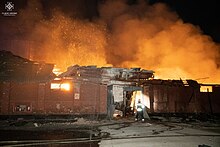
Cereals constitute the world's largest commodities by tonnage, whether measured by production[81]or by international trade. Several major producers of cereals dominate the market.[82]Because of the scale of the trade, some countries have become reliant on imports, thus cerealspricingor availability can have outsized impacts on countries with a food trade imbalance and thusfood security.[83]Speculation,as well as other compounding production and supply factors leading up to the2007–2008 financial crises,created rapid inflation of grain prices during the2007–2008 world food price crisis.[84]Other disruptions, such as climate change or war related changes to supply or transportation can create further food insecurity; for example theRussian invasion of Ukraine in 2022disrupted Ukrainian and Russian wheat supplies causing aglobal food price crisis in 2022that affected countries heavily dependent on wheat flour.[85][86][87][88]
Production
[edit]
Cereals are the world's largest crops by tonnage of grain produced.[81]Three cereals, maize, wheat, and rice, together accounted for 89% of all cereal production worldwide in 2012, and 43% of the global supply offood energyin 2009,[89]while the production of oats and rye has drastically fallen from their 1960s levels.[90]
Other cereals not included in the U.N.'sFood and Agriculture Organizationstatistics includewild rice,which is grown in small amounts in North America, andteff,an ancient grain that is a staple inEthiopia.[91]Teff is grown in sub-Saharan Africa as a grass primarily for feeding horses. It is high in fiber and protein. Its flour is often used to makeinjera.It can be eaten as a warm breakfast cereal likefarinawith a chocolate or nutty flavor.[91]
-
Production of cereals worldwide, by country in 2021
The table shows the annual production of cereals in 1961, 1980, 2000, 2010, and 2019/2020.[a][92][90]
| Grain | Worldwide production
(millions of metric tons) |
Notes | ||||
|---|---|---|---|---|---|---|
| 1961 | 1980 | 2000 | 2010 | 2019/20 | ||
| Maize(corn) | 205 | 397 | 592 | 852 | 1,148 | A staple food of people in the Americas, Africa, and oflivestockworldwide; often called corn in North America, Australia, and New Zealand. A large portion of maize crops are grown for purposes other than human consumption.[91] |
| Rice[b]Production is in milled terms. | 285 | 397 | 599 | 697 | 755 | The primary cereal of tropical and some temperate regions.Staple foodin most ofBrazil,other parts ofLatin Americaand some other Portuguese-descended cultures, parts of Africa (even more before theColumbian exchange), most ofSouth Asiaand theFar East.Largely overridden bybreadfruit(a dicot tree) during the South Pacific's part of theAustronesianexpansion.[91] |
| Wheat | 222 | 440 | 585 | 641 | 768 | The primary cereal of temperate regions. It has a worldwide consumption but it is a staple food of North America, Europe, Australia, New Zealand, Argentina, Brazil and much of theGreater Middle East.Wheat gluten-based meat substitutes are important in the Far East (albeit less thantofu) and are said to resemble meat texture more than others.[91] |
| Barley | 72 | 157 | 133 | 123 | 159 | Grown formaltingandlivestockon land too poor or too cold for wheat.[91] |
| Sorghum | 41 | 57 | 56 | 60 | 58 | Important staple food in Asia and Africa and popular worldwide for livestock.[91] |
| Millet | 26 | 25 | 28 | 33 | 28 | A group of similar cereals that form an important staple food in Asia and Africa.[91] |
| Oats | 50 | 41 | 26 | 20 | 23 | Popular worldwide as a breakfast food, such as inporridge,and livestock feed.[93] |
| Triticale | 0 | 0.17 | 9 | 14 | — | Hybridof wheat and rye, grown similarly to rye.[91] |
| Rye | 35 | 25 | 20 | 12 | 13 | Important in cold climates. Rye grain is used forflour,bread,beer,crispbread,somewhiskeys,somevodkas,and animalfodder.[91] |
| Fonio | 0.18 | 0.15 | 0.31 | 0.56 | — | Several varieties are grown as food crops in Africa.[91] |
Trade
[edit]
Cereals are the most tradedcommoditiesby quantity in 2021, with wheat, maize, and rice the main cereals involved. The Americas and Europe are the largest exporters, and Asia is the largest importer.[82]The largest exporter of maize is the US, while India is the largest exporter of rice. China is the largest importer of maize and of rice. Many other countries trade cereals, both as exporters and as importers.[82]Cereals aretraded as futureson worldcommodity markets,helping to mitigate the risks of changes in price for example, if harvests fail.[94]
-
Main traded cereals, top import, export in 2021
See also
[edit]Notes
[edit]References
[edit]- ^Renfrew, Colin; Bahn, Paul (2012).Archaeology: Theories, Methods, and Practice(6th ed.). Thames & Hudson. p. 277.ISBN978-0-500-28976-1.
- ^"The Development of Agriculture".National Geographic.Archived fromthe originalon 14 April 2016.Retrieved22 April2013.
- ^Hancock, James F. (2012).Plant evolution and the origin of crop species(3rd ed.). CABI. p. 119.ISBN978-1-84593-801-7.Archivedfrom the original on 4 May 2021.Retrieved10 February2021.
- ^UN Industrial Development Organization,International Fertilizer Development Center(1998).The Fertilizer Manual(3rd ed.).Springer Science and Business Media LLC.p. 46.ISBN978-0-7923-5032-3.Archivedfrom the original on 4 May 2021.Retrieved10 February2021.
- ^Purugganan, Michael D.; Fuller, Dorian Q. (1 February 2009)."The nature of selection during plant domestication"(PDF).Nature.457(7231): 843–848.Bibcode:2009Natur.457..843P.doi:10.1038/nature07895.ISSN0028-0836.PMID19212403.S2CID205216444.
- ^Henry, R.J.; Kettlewell, P.S. (1996).Cereal Grain Quality.Chapman & Hall.p. 155.ISBN978-9-4009-1513-8.
- ^Standage, Tom (2009).An Edible History of Humanity.New York: Walker & Company. pp. 27–28.ISBN978-1782391654.(pdf)
- ^Room, Adrian (1990).Who's Who in Classical Mythology.NTC Publishing. pp. 89–90.ISBN0-8442-5469-X.
- ^"cereal (n.)".Etymonline.Retrieved5 February2024.
- ^"JHOM - Bread - Hebrew".www.jhom.com.Archivedfrom the original on 26 October 2021.Retrieved27 August2022.
- ^Mayshar, Joram; Moav, Omer; Pascali, Luigi (2022)."The Origin of the State: Land Productivity or Appropriability?".Journal of Political Economy.130(4): 1091–1144.doi:10.1086/718372.hdl:10230/57736.S2CID244818703.Archivedfrom the original on 17 April 2022.Retrieved17 April2022.
- ^Kumar, Manoj; Williams, Matthias (29 January 2009)."Punjab, bread basket of India, hungers for change".Reuters.
- ^The Government of Punjab(2004).Human Development Report 2004, Punjab(PDF)(Report).Archived(PDF)from the original on 8 July 2011.Retrieved9 August2011.Section: "The Green Revolution", pp. 17–20.
- ^"Lessons from the green revolution: towards a new green revolution".Food and Agriculture Organization.Archivedfrom the original on 18 May 2017.Retrieved5 June2017.
The green revolution was a technology package comprising material components of improved high-yielding varieties (HYVs) of two staple cereals (rice or "wheat" ), irrigation or controlled "water" supply and improved moisture utilization, fertilizers and pesticides and associated management skills.
- ^abSands, David C.; Morris, Cindy E.; Dratz, Edward A.; Pilgeram, Alice L. (2009)."Elevating optimal human nutrition to a central goal of plant breeding and production of plant-based foods".Plant Science.177(5): 377–389.Bibcode:2009PlnSc.177..377S.doi:10.1016/j.plantsci.2009.07.011.PMC2866137.PMID20467463.
- ^"Did Quinoa Get Too Popular for Its Own Good?".HowStuffWorks.5 November 2018.Archivedfrom the original on 21 April 2021.Retrieved25 August2019.
- ^Juliano, Bienvenido O.; Tuaño, Arvin Paul P. (2019). "Gross structure and composition of the rice grain".Rice.Elsevier. pp. 31–53.doi:10.1016/b978-0-12-811508-4.00002-2.ISBN978-0-12-811508-4.
- ^Rosentrater & Evers 2018,p. 5.
- ^abcClayton, W.D.; Renvoise, S.A. (1986).Genera Graminum: Grasses of the world.London:Royal Botanic Gardens, Kew.ISBN978-1900347754.
- ^Cope, T.; Gray, A. (2009).Grasses of the British Isles.London:Botanical Society of Britain and Ireland.ISBN978-0901158420.
- ^"Insect Pollination of Grasses".Australian Journal of Entomology.3:74. 1964.doi:10.1111/j.1440-6055.1964.tb00625.x.
- ^Rosentrater & Evers 2018,pp. 2–3.
- ^Rosentrater & Evers 2018,pp. 68–69.
- ^abcdefghiBarr, Skylar; Sutton, Mason (2019).Technology of Cereals, Pulses and Oilseeds.Edtech. p. 54.ISBN9781839472619.Archivedfrom the original on 30 August 2022.Retrieved30 August2022.
- ^ab"The Rice Plant and How it Grows".International Rice Research Institute.Archived fromthe originalon 6 January 2009.
- ^Rosentrater & Evers 2018,pp. 3–4.
- ^"Best Crops for Grazing".Successful Farming.22 February 2018.Archivedfrom the original on 26 November 2020.Retrieved18 June2020.
- ^"Water Management".International Rice Research Institute.Retrieved4 November2023.
- ^Gupta, Phool Chand; O'Toole, J. C. O'Toole (1986).Upland Rice: A Global Perspective.International Rice Research Institute.ISBN978-971-10-4172-4.
- ^Danovich, Tove (15 December 2015)."Move over, quinoa: sorghum is the new 'wonder grain'".The Guardian.Retrieved31 July2018.
- ^"14th International Cereal Rusts and Powdery Mildews Conference".Aarhus University.2015. pp. 1–163.
- ^Goswami, R.; Kistler, H. (2004)."Heading for disaster:Fusarium graminearumon cereal crops ".Molecular Plant Pathology.5(6).John Wiley & Sons, Inc.:515–525.doi:10.1111/j.1364-3703.2004.00252.x.ISSN1464-6722.PMID20565626.S2CID11548015.
- ^Singleton, Grant R; Lorica, Renee P; Htwe, Nyo Me; Stuart, Alexander M (1 October 2021)."Rodent management and cereal production in Asia: Balancing food security and conservation".Pest Management Science.77(10): 4249–4261.doi:10.1002/ps.6462.PMID33949075.
- ^"Deer (Overview) Interaction with Humans - Damage to Agriculture | Wildlife Online".www.wildlifeonline.me.uk.Retrieved8 February2024.
- ^Constable, George; Somerville, Bob (2003).A Century of Innovation: Twenty Engineering Achievements That Transformed Our Lives, Chapter 7, Agricultural Mechanization.Washington, DC:Joseph Henry Press.ISBN0-309-08908-5.Archivedfrom the original on 21 May 2019.Retrieved30 August2022.
- ^"Cereal Straw".University of Kentucky.Archivedfrom the original on 29 March 2019.Retrieved9 February2024.
- ^Walker, Pete; Thomson, A.; Maskell, D. (2020). "Straw bale construction".Nonconventional and Vernacular Construction Materials.Elsevier. pp. 189–216.doi:10.1016/b978-0-08-102704-2.00009-3.ISBN978-0-08-102704-2.
- ^Erkmen, Osman; Bozoglu, T. Faruk, eds. (2016). "Spoilage of Cereals and Cereal Products".Food Microbiology: Principles into Practice.Wiley. pp. 364–375.doi:10.1002/9781119237860.ch21.ISBN978-1-119-23776-1.
- ^Papageorgiou, Maria; Skendi, Adriana (2018)."1 Introduction to cereal processing and by-products".In Galanakis, Charis M. (ed.).Sustainable Recovery and Reutilization of Cereal Processing By-Products.Woodhead Publishing Series in Food Science, Technology and Nutrition. Woodhead Publishing. pp. 1–25.ISBN978-0-08-102162-0.Retrieved9 February2024.
- ^Astier, Marta; Odenthal, Georg; Patricio, Carmen; Orozco-Ramírez, Quetzalcoatl (2 January 2019). "Handmade tortilla production in the basins of lakes Pátzcuaro and Zirahuén, Mexico".Journal of Maps.15(1). Informa UK: 52–57.Bibcode:2019JMaps..15...52A.doi:10.1080/17445647.2019.1576553.ISSN1744-5647.
- ^"Varieties".Rice Association.2 August 2018. Archived fromthe originalon 2 August 2018.Retrieved9 February2024.
- ^"The Malting Process".Brewing With Briess.Retrieved9 February2024.
- ^"Malting - an overview".Science Direct.Retrieved9 February2024.
- ^abJacobs, Paul Burke (1938).Information on Industrial Alcohol.U.S. Department of Agriculture, Bureau of Chemistry and Soils. pp. 3–4.Archivedfrom the original on 30 August 2022.Retrieved29 August2022.
- ^abBarth, Roger (2013). "1. Overview".The Chemistry of Beer: The Science in the Suds.Wiley.ISBN978-1-118-67497-0.
- ^"Standards of Identity for Distilled Spirits, Title 27 Code of Federal Regulations, Pt. 5.22"(PDF).Retrieved17 October2008.
Bourbon whiskey... Corn whiskey... Malt whiskey... Rye whiskey... Wheat whiskey
- ^abBorrell, Brendan (20 August 2009)."The Origin of Wine".Scientific American.
- ^Briggs, D. E. (1978). "Some uses of barley malt".Barley.Dordrecht: Springer Netherlands. pp. 560–586.doi:10.1007/978-94-009-5715-2_16.ISBN978-94-009-5717-6.
products include malt extracts (powders and syrups), diastase, beer, whisky,... and malt vinegar.
- ^"International Starch: Production of corn starch".Starch.dk.Archivedfrom the original on 15 May 2011.Retrieved12 June2011.
- ^"Glucose-fructose syrup: How is it produced?".European Food Information Council (EUFIC). Archived fromthe originalon 17 May 2017.Retrieved9 February2024.
- ^Takken, Ingrid; Govers, Gerard; Jetten, Victor; Nachtergaele, Jeroen; Steegen, An; Poesen, Jean (2001)."Effects of tillage on runoff and erosion patterns".Soil and Tillage Research.61(1–2). Elsevier: 55–60.Bibcode:2001STilR..61...55T.doi:10.1016/s0167-1987(01)00178-7.ISSN0167-1987.
- ^Sundquist, Bruce (2007)."1 Irrigation overview".The Earth's Carrying Capacity: some literature reviews.Archived fromthe originalon 17 February 2012.Retrieved8 February2024.
- ^Mbow, C.; Rosenzweig, C.; Barioni, L. G.; Benton, T.; et al. (2019)."Chapter 5: Food Security"(PDF).Climate Change and Land: an IPCC special report on climate change, desertification, land degradation, sustainable land management, food security, and greenhouse gas fluxes in terrestrial ecosystems.p. 454.
- ^Werner, Wilfried (2009). "6. Environmental Aspects".Fertilizers.Wiley.doi:10.1002/14356007.n10_n05.ISBN978-3-527-30385-4.
- ^Nabuurs, G-J.; Mrabet, R.; Abu Hatab, A.; Bustamante, M.; et al."7: Agriculture, Forestry and Other Land Uses"(PDF).Climate Change 2022: Mitigation of Climate Change.p. 750.doi:10.1017/9781009157926.009.
- ^"Neonicotinoids: risks to bees confirmed".European Food Safety Authority.28 February 2018.Retrieved23 June2023.
- ^Kaplan, Sarah."A recipe for fighting climate change and feeding the world".The Washington Post.Retrieved19 November2021.
- ^Glover, Jerry D.; Cox, Cindy M.; Reganold, John P. (2007)."Future Farming: A Return to Roots?"(PDF).Scientific American.297(2): 82–89.Bibcode:2007SciAm.297b..82G.doi:10.1038/scientificamerican0807-82.PMID17894176.
- ^Jensen, Erik Steen; Carlsson, Georg; Hauggaard-Nielsen, Henrik (2020)."Intercropping of grain legumes and cereals improves the use of soil N resources and reduces the requirement for synthetic fertilizer N: A global-scale analysis".Agronomy for Sustainable Development.40(1). Springer Science and Business Media.doi:10.1007/s13593-020-0607-x.ISSN1774-0746.
- ^Vermeulen, S.J.; Dinesh, D. (2016)."Measures for climate change adaptation in agriculture. Opportunities for climate action in agricultural systems. CCAFS Info Note".Copenhagen, Denmark: CGIAR Research Program on Climate Change, Agriculture and Food Security.
- ^"How to cook perfect rice".BBC Food.Archivedfrom the original on 27 August 2022.Retrieved27 August2022.
- ^Davidson 2014,pp. 642–643 Porridge.
- ^Bilow, Rochelle (17 September 2015)."What's the difference between muesli and granola? A very important primer".Bon Appétit.Condé Nast.Retrieved6 June2022.
- ^Vaclavik, Vickie A.; Christian, Elizabeth W. (2008). "Grains: Cereal, Flour, Rice, and Pasta".Essentials of Food Science.New York: Springer New York. pp. 81–105.doi:10.1007/978-0-387-69940-0_6.ISBN978-0-387-69939-4.
- ^"The history of flour - The FlourWorld Museum Wittenburg – Flour Sacks of the World".flour-art-museum.de.Archivedfrom the original on 27 February 2021.Retrieved30 August2022.
- ^Peña, R. J."Wheat for bread and other foods".Food and Agriculture Organization.Archivedfrom the original on 27 January 2019.Retrieved30 August2022.
Wheat, in the form of bread, provides more nutrients to the world population than any other single food source.
- ^Davidson 2014,pp. 516–517 Mexico.
- ^"Medieval Daily Bread Made of Rye".Medieval Histories.15 January 2017.Retrieved8 February2024.
Sources: Råg. Article inKulturhistorisk leksikon for Nordisk Middelalder.Rosenkilde and Bagger 1982.
- ^Davidson 2014,p. 682 Rice.
- ^ab"Cereals and wholegrain foods".Better Health Channel.6 December 2023.Retrieved8 February2024.
in consultation with and approved by Victoria State Government Depertment of Health; Deakin University
- ^Davidson 2014,pp. 315–316 Flour.
- ^Davidson 2014,p. 701.
- ^"Cereals in poultry diets – Small and backyard poultry".poultry.extension.org.Retrieved10 February2024.
- ^"Feeding cereal grains to livestock: moist vs dry grain".Agriculture and Horticulture Development Board.Retrieved5 February2024.
- ^Thomas, M.; van Vliet, T.; van der Poel, A.F.B. (1998). "Physical quality of pelleted animal feed 3. Contribution of feedstuff components".Animal Feed Science and Technology.70(1–2): 59–78.doi:10.1016/S0377-8401(97)00072-2.
- ^"Storing Whole Grains".Whole Grains Council.Retrieved10 February2024.
- ^Mundell, E.J. (9 July 2019)."More Americans Are Eating Whole Grains, But Intake Still Too Low".HealthDay.Archivedfrom the original on 2 November 2021.Retrieved31 May2021.
- ^Prime Mover: A Natural History of Muscle.W.W. Norton & Company.17 August 2003. p.301.ISBN9780393247312..
- ^Edwards, J.S.; Bartley, E.E.; Dayton, A.D. (1980)."Effects of Dietary Protein Concentration on Lactating Cows".Journal of Dairy Science.63(2): 243.doi:10.3168/jds.S0022-0302(80)82920-1.
- ^"FoodData Central".US Department of Agriculture.Retrieved8 February2024.
- ^ab"IDRC - International Development Research Centre".International Development Research Centre.Archivedfrom the original on 9 June 2016.
- ^abcWorld Food and Agriculture – Statistical Yearbook 2023.Food and Agriculture Organization. 2023.doi:10.4060/cc8166en.ISBN978-92-5-138262-2.Retrieved13 December2023.
- ^OECD; Food and Agriculture Organization of the United Nations (6 July 2023)."3. Cereals".OECD-FAO Agricultural Outlook 2023-2032.OECD.doi:10.1787/19991142.ISBN978-92-64-61933-3.
- ^"World Food Situation".FAO.Archivedfrom the original on 29 April 2011.Retrieved24 April2011.
- ^Pei, Qing; Zhang, David Dian; Xu, Jingjing (August 2014). "Price Responses of Grain Market under Climate Change in Pre-industrial Western Europe by ARX Modelling".Proceedings of the 4th International Conference on Simulation and Modeling Methodologies, Technologies and Applications.pp. 811–817.doi:10.5220/0005025208110817.ISBN978-989-758-038-3.S2CID8045747.
{{cite book}}:|journal=ignored (help) - ^"Climate Change is Likely to Devastate the Global Food Supply".Time.Retrieved2 April2022.
- ^"CLIMATE CHANGE LINKED TO GLOBAL RISE IN FOOD PRICES – Climate Change".Archived fromthe originalon 18 October 2022.Retrieved2 April2022.
- ^Lustgarten, Abrahm (16 December 2020)."How Russia Wins the Climate Crisis".The New York Times.ISSN0362-4331.Retrieved2 April2022.
- ^"ProdSTAT".FAOSTAT.Archivedfrom the original on 10 February 2012.Retrieved9 July2020.
- ^abRitchie, Hannah;Roser, Max(17 October 2013)."Crop Yields".Our World in Data.Archivedfrom the original on 27 July 2017.Retrieved30 August2022.
- ^abcdefghijkWrigley, Colin W.; Corke, Harold; Seetharaman, Koushik; Faubion, Jonathan, eds. (2016).Encyclopedia of food grains(2nd ed.). Kidlington, Oxford, England:Academic Press.ISBN978-0-12-394786-4.OCLC939553708.Archivedfrom the original on 30 August 2022.Retrieved30 August2022.
- ^Food and Agriculture Organization of the United Nations."FAOSTAT".FAOSTAT(Food and Agriculture Organization Statistics Division).Archivedfrom the original on 6 January 2022.Retrieved30 August2022.
- ^"Types of Oats".Whole Grains Council.Archivedfrom the original on 29 June 2015.Retrieved25 June2015.
- ^Atkin, Michael (2024). "6. Grains".Agricultural Commodity Markets: A Guide to Futures Trading.Taylor & Francis.ISBN9781003845379.
Sources
[edit] This article incorporates text from afree contentwork. Licensed under CC BY-SA IGO 3.0 (license statement/permission). Text taken fromWorld Food and Agriculture – Statistical Yearbook 2023,FAO, FAO.
This article incorporates text from afree contentwork. Licensed under CC BY-SA IGO 3.0 (license statement/permission). Text taken fromWorld Food and Agriculture – Statistical Yearbook 2023,FAO, FAO.- Davidson, Alan(2014). "Mexico".The Oxford Companion to Food(3rd ed.).Oxford University Press.ISBN978-0-19-967733-7.
- Rosentrater, Kurt August; Evers, Anthony D. (2018).Kent's Technology of Cereals: An Introduction for Students of Food Science and Agriculture(5th ed.). Duxford, England.ISBN978-0-08-100532-3.OCLC1004672994.
{{cite book}}:CS1 maint: location missing publisher (link)

